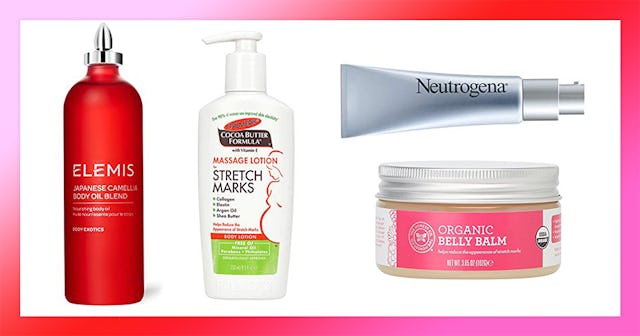These Stretch Mark Treatments Are Actually Worth Buying (Whether You're Pregnant Or Postpartum)

The best stretch mark treatments — whether in the form of lotions, oils, balms, and butters — nourish skin and help it heal (it’s self-care, amiright?). Although stretch marks should be considered a badge of honor, if you wish your badge were a little less, um, shiny, we’re here to help. While many pregnancy side-effects are short-term— like morning sickness that lasts all day, heartburn that lasts all night, postpartum hair loss, or the inability to hold in your pee after a light sneeze— others are long-lasting. Some are even with us, well, forever. And we’re totally okay with that, but we’re also totally okay with helping you find safe solutions if you’d prefer these scars to fade. Enter, pregnancy stretch mark products.
Turns out, some of the peskiest and most common pregnancy hold-overs that last well after your Baby makes their big debut are skin issues— usually in the form of stretch marks or hyperpigmentation (aka melasma, or “pregnancy mask”). Stretch marks are also hormone-related, and they also happen when our skin stretches (or shrinks) in a short amount of time. They can happen to non-pregnant folk too—from growth spurts or weight gain/loss. “When stretch marks are forming initially, collagen, which is responsible for the structure of our skin, becomes thickened and then heals with an abnormal pattern,” explains Papri Sarkar, M.D., a dermatologist in Brookline, Massachusetts. “In addition, elastin, which is responsible for the ability of our skin to snap back to shape, is decreased.” The result? Lovingly loose skin that starts out red or purple and then gradually fades to whitish lines that are sunken into the skin.
The good news about stretch marks? They get better over time (in other words, they fade). And, in the interim, there are some really great products out there that can help them fade faster. Here are some answers to FAQ, as well as dermatologist-recommended products that tackle stretch marks.
What causes stretch marks?
“Stretch marks happen when the skin expands faster than it can keep up with, leading to an inflammatory response that causes redness before turning lighter in the healing phase,” explains Erum Ilyas, M.D., a dermatologist at Montgomery Dermatology in King of Prussia, Pennsylvania. That means they can form with weight or muscle gain, and of course, during pregnancy. With the latter, you may see the squiggles appear on your stomach, of course, but also on your bum, thighs, arms, breasts — really anywhere that expands as your baby develops. At first, they can appear red or purple, but they usually fade to white postpartum. The degree to which you get stretch marks can also have to do with genetics — some women don’t get stretch marks at all (although, most do).
Can you avoid stretch marks during pregnancy?
To an extent, there’s no guarantee you won’t get any stretch marks, no matter how diligently you try to avoid them. That said, some things can be done to help prevent these lines or minimize their appearance once your baby is born. “The key here is to keep the skin well moisturized,” advises Dr. Jennifer Conti, Ob/Gyn and Modern Fertility Medical Advisor (Twitter: @doctorjenn). However, she admits, “The biggest predisposing factor for stretch marks is genetics: Some people just naturally are prone to stretch marks whereas others are not. Vitamin E oil is a great option for moisturizing and is good for all bellies.”
What is the best treatment for stretch marks?
The first step is to use nourishing, pregnancy-safe products — usually in the form of creams, oils, balms, and butters — on your growing belly (and anywhere else you think they might form). Because stretch marks are, in many ways, scar tissue, applying a thick emollient to soften skin can lead to some improvement, according to Dr. Ilyas. “Since there is little that a cream can do to actually treat the scars, using hydrating products to improve the turgor of the skin within the stretched skin and improve the overall appearance of the skin. It reduces the crepe-like or tissue paper-like wrinkling of the skin overlying a stretch mark.”
Effective ingredients that are safe to use during pregnancy include cocoa butter, vitamin E, coconut oil, argan oil, peptides, and hyaluronic acid. To reduce the appearance of postpartum stretch marks, you can enlist the help of stronger treatments like products with retinoids, but these, as well as other chemical ingredients and even essential oils, should be avoided during pregnancy and breastfeeding. (And if you have any concerns, be sure to ask your doc.) Dr. Conti also recommends that moms-to-be check out skincare ingredients on the Environmental Working Group site, “which has a wealth of information about various skincare products and their safety in reproductive health.”
Now that we’ve covered the basics, check out our favorite pregnancy stretch mark treatment picks:
Best Stretch Mark Creams, Butters & Balms For Pregnancy
Best Stretch Mark Oils For Pregnancy
Best Postpartum Stretch Mark Creams For After Pregnancy & Breastfeeding
In which month of pregnancy do stretch marks appear?
Again, it depends on the individual. They often appear around months 3 or 4, but they could make their debut — or worsen — in the third trimester.
How long does it take for pregnancy stretch marks to go away?
While they may not “go away” entirely, they should be much less noticeable 6 to 12 months postpartum. Also, the products above can help!
SHOP THE STORY
This article was originally published on